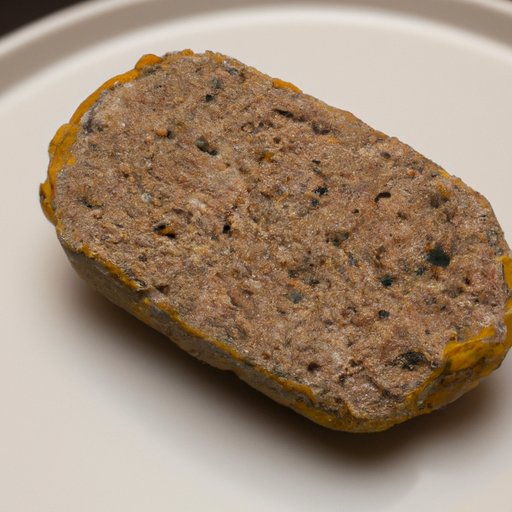I. Introduction
Meatloaf can be a delicious and easy-to-make dish, but cooking it to the right temperature is essential for both taste and safety. In this article, we’ll explore the ideal temperature range for cooking meatloaf, why it’s important to do so, and provide tips for achieving the perfect temperature. We’ll also discuss how to determine when your meatloaf is done, the various methods to check if it’s cooked properly, and how internal temperature affects the texture and taste. Finally, we’ll provide temperature guidelines for preventing overcooking and a few tips to help you achieve your desired results. So, let’s dive in and make the perfect meatloaf.
II. The Ultimate Guide to Meatloaf Temperatures: How to Cook Meatloaf to Perfection
The ideal temperature range for cooking meatloaf is between 350-375°F (176-190°C). This temperature range ensures that the meatloaf is cooked through without overcooking it. Overcooking can lead to a dry and tough meatloaf, which is not appetizing.
Cooking meatloaf to the right temperature is important for both taste and safety. Undercooked meatloaf can be dangerous as it can harbor harmful bacteria such as E. coli and Salmonella. These bacteria can cause severe food poisoning if ingested, which is why it’s crucial to cook meatloaf to the right temperature.
To achieve the perfect temperature, there are a few tips you should follow. First, use a meat thermometer to determine the internal temperature. Second, ensure that the oven is at the right temperature before placing the meatloaf in the oven. Third, let the meatloaf rest for a few minutes after cooking to allow juices to redistribute evenly throughout the meatloaf.
III. Don’t Serve Undercooked Meatloaf: Tips on How to Find Out When It’s Done
Undercooked meatloaf can be dangerous, so you need to know how to identify it. The signs of undercooked meatloaf include a pink color in the center, a mushy texture, and the juices appearing slightly pink.
The best way to avoid undercooked meatloaf is to use a meat thermometer to determine the internal temperature. The internal temperature should reach 160°F (70°C) for beef, pork, or veal meatloaf, and 165°F (75°C) for turkey or chicken meatloaf.
IV. The Temperature Game: How to Check if Your Meatloaf is Cooked Perfectly
There are different methods to check if meatloaf is cooked correctly. The most reliable method is to use a meat thermometer. Insert the thermometer into the thickest part of the meatloaf, and ensure that it doesn’t touch the loaf’s bottom or the pan. Once the internal temperature reaches 160°F (70°C) for beef, pork, or veal meatloaf, or 165°F (75°C) for turkey or chicken meatloaf, it’s done.
Other methods include checking the meatloaf’s color or juices. However, these methods are not as reliable as they can vary depending on the type of meat you’re using, the spices, and other factors. The color or juices are also not a reliable indicator of the meatloaf’s internal temperature.
To ensure perfect results, we recommend using a meat thermometer to check the internal temperature of the meatloaf.
V. From Raw to Cooked: The Process of Determining Meatloaf’s Done Temperature
Measuring meatloaf’s temperature is essential for ensuring that it’s cooked correctly. You should measure the internal temperature, which is the temperature of the meatloaf’s center.
There are different stages of meatloaf cooking, including the initial cooking phase, the middle cooking phase, and the final cooking phase. The initial cooking phase is when the meatloaf is heated quickly, and the internal temperature rises rapidly. The middle cooking phase is where the meatloaf’s internal temperature increases slowly, and the final cooking phase is where the meatloaf’s internal temperature plateaus.
To determine when meatloaf is done, you need to measure its temperature at different stages of cooking. Use a meat thermometer, and measure the temperature after 20-30 minutes of cooking, halfway through cooking, and after reaching the recommended temperature.
VI. The Perfect Meatloaf: How to Use Internal Temperature to Achieve Your Dream Dish
The internal temperature of the meatloaf affects its texture and taste. If the meatloaf has a higher internal temperature, it’s denser and dryer. If it’s cooked to a lower internal temperature, it’s more tender and juicier. Therefore, the internal temperature is crucial in achieving your desired result.
To adjust the internal temperature, you can change the cooking time or oven temperature. If you want a more tender and juicy meatloaf, cook it at a lower temperature or for a shorter time. A higher temperature or a longer cooking time will result in a denser and dryer meatloaf.
Once the internal temperature reaches the recommended temperature, you should test the meatloaf for doneness. To do this, insert a meat thermometer in the center of the meatloaf and ensure that it reads the recommended temperature (160°F for beef, pork, or veal meatloaf, and 165°F for turkey or chicken meatloaf).
VII. Say Goodbye to Overcooked Meatloaf: Follow These Temperature Guidelines for Ideal Results
Overcooked meatloaf is unappetizing, dry, and tough. To prevent overcooking, follow these temperature guidelines:
- Preheat the oven to the recommended temperature before placing the meatloaf in the oven. This ensures that the meatloaf will cook evenly and at the right temperature.
- Check the meatloaf’s temperature while cooking. Use a meat thermometer to measure the internal temperature. The meatloaf should reach 160°F (70°C) for beef, pork, or veal meatloaf, and 165°F (75°C) for turkey or chicken meatloaf.
- Let the meatloaf rest for a few minutes after cooking to allow the juices to redistribute evenly throughout the meatloaf. This ensures that the meatloaf is moist and tender.
VIII. Conclusion
Cooking meatloaf to the right temperature is crucial for both taste and safety. Undercooked meatloaf can be dangerous, while overcooked meatloaf is unappetizing. To achieve the perfect meatloaf, use a meat thermometer to check the internal temperature, and follow the temperature guidelines. Remember to adjust the internal temperature to achieve your desired result, and test the meatloaf for doneness. By following these tips, you’ll make the perfect meatloaf every time.
